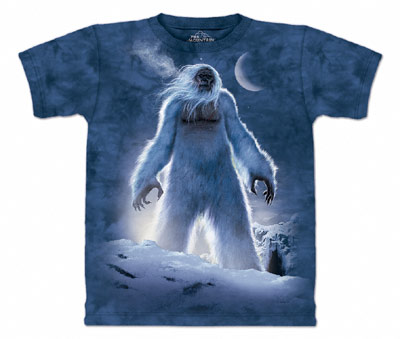
李薇 注
The Yeti is an animal that walks on two legs like a man, but is hairy.[1] Over the years, many people say they’ve seen one, especially in the mountains. So far, there is no proof. Have you heard of strange animals like this, such as the Scottish Loch Ness Monster[2]? Do you believe in them?
A: This is a story about the Yeti. There has been a sighting[3]!
B: What’s a Yeti?
A: He’s a creature, also known as The Abominable Snowman or Bigfoot[4]. People catch glimpses of him from time to time, but nobody’s sure if he’s real. They haven’t caught one yet.
B: Is he kind of like the Loch Ness Monster? I already know about that one.
A: Yes, he’s an almost extinct hairy animal who walks on two legs like a human and leaves big tracks, so they call him “Bigfoot”.
B: I see. Is he like a missing link, between an ape and a human?[5]
A: Perhaps. Someone saw him yesterday in the Rocky Mountains[6]. They took a picture. Have you seen it yet? It’s a little fuzzy. Still, you can see his outline.
B: Oh, that. Yes, I saw it this morning. I didn’t read the caption. It’s pretty blurry, it could be anything.
A: Here’s another picture, taken in Asia ten years back, and yet another.
B: I’ve already seen them. They’re yet more unclear. I can make out[7] nothing.
A: Yes, but Yeti don’t stand still for pictures. They’re strong yet shy. They run away from people. That’s why they’ve yet to get a convincing picture.
B: I see. Do you believe in Bigfoot?
A: I’m open[8] to it. How about you?
B: I’m inclined to think it’s a hoax. People claim they’ve seen one, yet they haven’t found a Yeti yet. Still, it’s a nice fantasy[9].
A: Don’t dismiss it out of hand. Aliens[10] are stranger still, yet many scientists believe they exist.
B: I still think it’s all rubbish. Why do you believe in Bigfoot?
A: Because I think my mother-in-law[11] is one.
Vocabulary
1. Yeti: (传说中喜马拉雅山的)雪人;hairy: 多毛的。
2. Loch Ness Monster: 尼斯湖水怪。
3. sighting: 目击,看见(不寻常的事物)。
4. Bigfoot: 大脚,长毛野人(传说生存于美国西北部山区的长毛猿人)。
5. missing link: (类人猿进化到人类的过程中)或许存在过的一种过渡动物;ape: 猿。
6. Rocky Mountains: 落基山脉,位于北美洲西部,北起阿拉斯加北部,纵贯加拿大和美国西部,南至墨西哥边境。
7. make out: 看出,辨认出。
8. open: 不对某事存先入之见。
9. fantasy: 幻想,想像。
10. alien: 外星人。
11. mother-in-law: 岳母,丈母娘。
Exercise
1. abominable a. I won’t use your idea or think about it
2. catch a glimpse of b. tending to behave in a particular way
3. from time to time c. animal kind is all dead now
4. extinct d. not clear
5. tracks e. not clear
6. fuzzy f. to state that something is true, even though it
has not been proved
7. outline g. it’s not just a story, but is real in the world
8. caption h. see (only for a second)
9. blurry i. footprints
10. convincing j. garbage or nonsense (you’re wrong, I disagree)
11. inclined k. only sometimes, not regularly
12. hoax l. writing under a picture to explain it
13. claim m. the shape around it
14. dismiss it out of hand n. making you believe that something is true or right
15. exist o. terrible
16. rubbish p. trick. Makes many people believe a lie (for fame/cash)
Answers: 1–o, 2–h, 3–k, 4–c, 5–i, 6–e, 7–m, 8–l, 9–d, 10–n, 11–b, 12–p, 13–f, 14–a, 15–g, 16–j.
Usage Tips
本期内容中用了很多的yet,但依语境的不同,yet有着不同的含义。现列举几个常用的用法:
a) 作副词,意思是“尚未,仍未”,常用在否定句中,如:I haven’t seen it yet. / It isn’t dark yet.
b) 作副词,意思是“还”,“仍然”,“仍旧”,如:There is hope for her yet.
c) 作副词,意思是“然而,不过”,如:strong yet shy或young yet wise。
d) 作副词,意思是“已经”,常用于疑问句,如:Have you had your dinner yet?
e) 作连词,意思是“然而,可是”,用于连接句子,表示含惊讶之意的转折,如:She promised she would be early, yet she arrived quite late.
(来源:英语学习杂志)